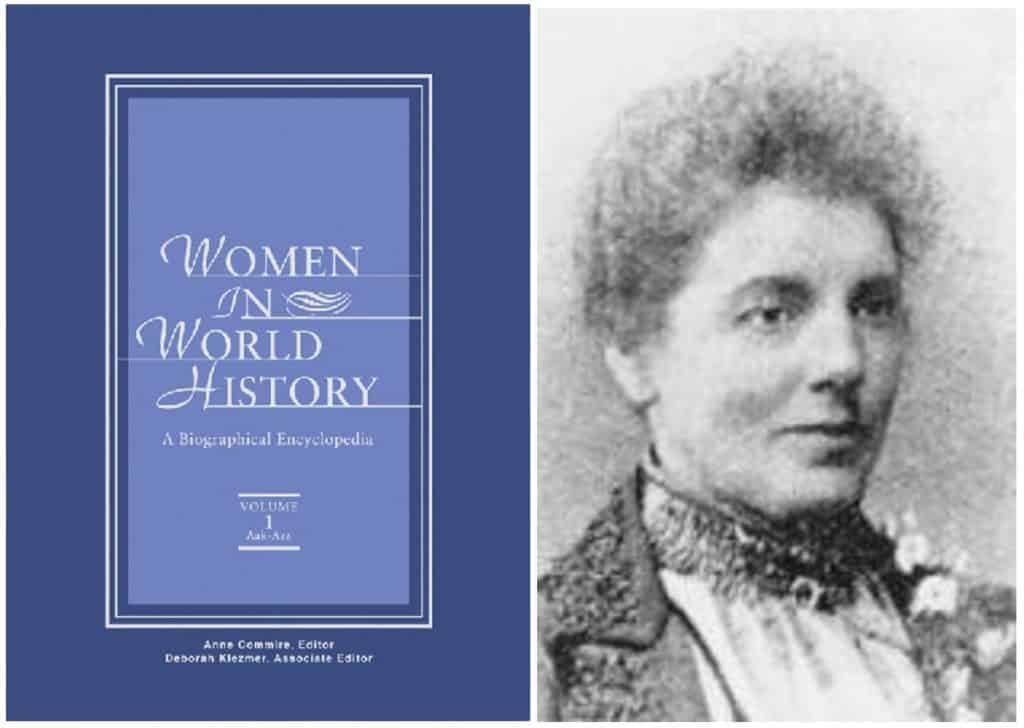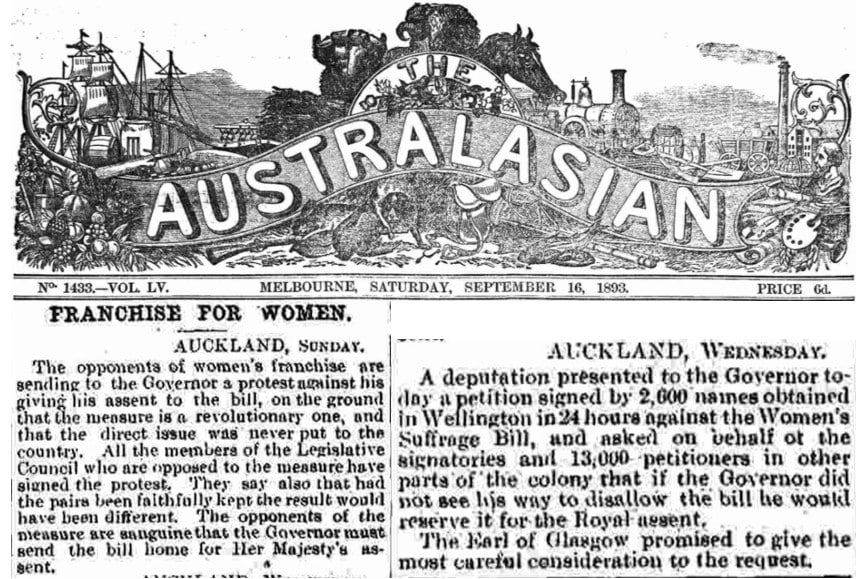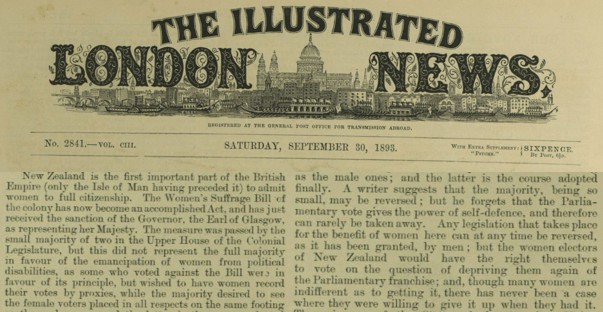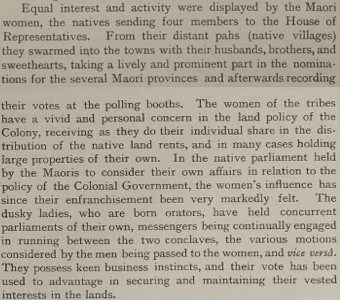│By Darren Brain, Senior Sales and Marketing Executive, Gale Australia and New Zealand│
On September 19, 2021, it will be 128 years since New Zealand’s Governor, Lord Glasgow, signed the Electoral Act granting women the right to vote in parliamentary elections. With this Act, New Zealand became the first self-governing country in the world to legislate women’s voting rights into law. As we celebrate the anniversary of this landmark decision in 1893 I wondered – what’s the story behind the fight for women’s suffrage in New Zealand? How did the people of New Zealand accept this major change at the end of the nineteenth century? And how did this important decision change the future of New Zealand’s society? Was it the end of the fight – or just the first battle?
The Road to Suffrage
New Zealand’s fight for women’s suffrage began in the late nineteenth century as an extension of similar campaigns that had started to spread throughout Britain and the British colonies, Northern Europe and the United States. The women’s suffrage movement was driven by two key themes: equal political rights for women and societal moral reform (particularly alcohol). In 1885, New Zealand women established their own Women’s Christian Temperance Union, based on the American organisation founded in 1873.
The New Zealand Women’s Christian Temperance Union (WCTU) was led by Kate Sheppard, a key figure in the founding of the WCTU and one of the leading voices for women’s suffrage in New Zealand. You can find out more about Kate Sheppard and other important women in history in Women in World History: A Biographical Encyclopedia on the Gale eBooks platform.

Victory in New Zealand
The WCTU had the support of several key male politicians in the New Zealand Parliament including Sir Robert Stout, John Hall and William Fox. Several attempts to extend the vote to women by introducing bills or amendments had already been made in 1878, 1879 and 1887, but failed. Following the establishment of the WCTU in 1885 and the leadership of Kate Sheppard, support began to increase, and momentum began to grow. A petition was presented to Parliament in 1893 containing approximately 32,000 signatures. However, the opponents of women’s suffrage were also mobilising. Their efforts to stop the movement were supported heavily by the liquor industry, who extensively lobbied the all-male Members of Parliament.
After more failed attempts to get a bill through both Houses of Parliament in 1891 and 1892, another attempt in April 1893 was passed by the House of Representatives and following months of intense lobbying and politicking, the Legislative Council passed the bill by two votes (20-18) on September 8, 1893. Whilst it still awaited consent by the Governor, Lord Glasgow, to become law, the bill had finally passed. The Victory in New Zealand was announced in newspapers worldwide such as The Women’s Herald which can be found in Gale’s Women’s Studies Archive: Voice and Vision, a British newspaper that expressed their envy and congratulations to their New Zealand sisters.
!["Victory in New Zealand." Woman's Herald, no. 30, 14 Sept. 1893, p. [465]. Women's Studies Archive, https://link.gale.com/apps/doc/YRMPDP894084612/GDCS?u=darrenandsid=bookmark-GDCSandxid=bd6beae6](https://review.gale.com/wp-content/uploads/2021/09/Womens-Herald-WSA.jpg)
Reaction to the Victory
Analysing various newspapers and documents of the time, I discovered that there was a range of reactions to the landmark decision by the New Zealand Parliament. In her column “For Wives and Daughters,” in the Northampton Mercury, which can be found in British Library Newspapers: Part III: 1741-1950, a Madame Rose wrote that it was a surprise victory and the first experiment of its kind in the world, but “the experience of a colony will, however, furnish but an indifferent guide for the mother country, where the social conditions and the social problems are essentially different.” Madame Rose was correct as Britain didn’t allow women over the age of 21 to vote until 1928.

Melbourne’s The Australasian newspaper which can be found in Gale’s Nineteenth Century UK Periodicals Part II: Empire described the desperate measures taken by opponents of women’s suffrage in New Zealand as they looked for parliamentary loopholes. A deputation presented a petition to the Governor, Lord Glasgow, asking that he must “send the bill home for her Majesty’s assent…”, hoping that Queen Victoria would intervene.

The Governor Gives Consent
Their lobbying and protests were in vain as the Governor, Lord Glasgow sanctioned the act eleven days later on September 19, 1893. Some opponents however, still believed that, due to the small majority of the vote, it could be overturned. The Illustrated London News Historical Archive, 1842-2003, wrote about the possibility of the law being reversed, but observed that “the women electors of New Zealand would have the right themselves to vote on the question of depriving them again of the Parliamentary franchise” effectively guaranteeing that law would not be overturned!

Nearly a year after women’s suffrage became law in New Zealand, Kate Sheppard reflected on the journey and challenges they faced and overcame to achieve this historic change. In an article for The Women’s Signal Budget which can be found in Gale’s Women’s Studies Archive: Voice and Vision, Sheppard wrote that initially women overall weren’t fully committed to their need for direct representation “until they found that all attempts at reform were practically futile without it”. She went on to discuss how, within two months of the law being passed, over 109,461 women were enrolled to vote and 90,290 women voted in their first New Zealand general election on November 28, 1893.

In a 1906 article for The Women’s Tribune which can be found in Gale’s Women’s Studies Archive: Voice and Vision, M. Hirst Alexander tells the story of women’s suffrage in “The Granting of the Franchise in Australasia” starting with the challenges and ultimate victory in New Zealand. Alexander then discusses the effect and interest of women’s suffrage by Māori women, the Indigenous People of New Zealand. Explaining that Māori women “have a vivid and personal concern in the land policy of the Colony, receiving as they do their individual share in the distribution of the native land rents, and in many cases holding large properties of their own”. Alexander went on to describe progress in Australia, with South Australia being the first Australian colony to grant full suffrage in 1895, followed by Western Australia in 1899, then the newly formed Australian Commonwealth in 1902, and finally from an Australian state perspective: New South Wales in 1902, Tasmania in 1903, Queensland in 1905 and finally, Victoria in 1908.

What was the effect of Women’s Suffrage in New Zealand?
Lady Anna Stout was another important and influential figure in New Zealand’s women’s suffrage movement, joining the WCTU in 1885 and was elected president of the Women’s Franchise League in Dunedin in 1892. Lady Stout wrote an article for The Women’s Press which can be found in Gale’s Nineteenth Century Collections Online: Women and Transnational Networks describing the achievements of “Woman Suffrage in New Zealand” which included admitting women to practise at the Bar, equality for school and university education, child protection, child slavery and old age pensions.
Finally, in another article published by the National American Woman Suffrage in Gale’s Nineteenth Century Collections Online: Women and Transnational Networks titled “Woman Suffrage in New Zealand,” the success of women’s suffrage in New Zealand is used as evidence – “Women’s parliamentary suffrage tried, and tried successfully, is worthy of your attention, even at the antipodes”! The author continues outlining the varied impacts of women’s suffrage, suggesting “people are beginning to look at customs and institutions with different eyes”.
![Stout. Woman Suffrage in New Zealand. The Woman's Press, [1912?]. Nineteenth Century Collections Online, https://link.gale.com/apps/doc/AZGGAF766314798/GDCS?u=darrenandsid=bookmark-GDCSandxid=d6b5aef5andpg=6](https://review.gale.com/wp-content/uploads/2021/09/Lady-Stout-NCCO.jpg)
The fight for women’s equality is far from over
For some time, Gale has been publishing primary source archives that are important resources for researching women’s studies including the Women’s Studies Archive series, Nineteenth Century Collections Online and Gale Historical Newspapers. The Gale Primary Sources platform is the perfect place to cross-search and examine these resources, to research what actually happened, what it meant for New Zealand and understand the mood of 1890’s society in New Zealand and the world.
As I prepared this post in early September, our family celebrated the eleventh birthday of my daughter and I reflected on how far the fight for women’s rights and equality has come since the nineteenth century and what the world will look like when she becomes an adult. What about the rest of the world’s daughters? The fight for women’s rights and equality is far from over.
If you enjoyed reading about the fight for women’s suffrage in New Zealand, you may like:
- Free from Male Influence: The Second Wave Feminist Press
- Leading Ladies: The actresses who fought for women’s suffrage
- How primary sources have shown me a different side to the women’s suffrage movement
- Discovering New Points of View about European and Colonised Women Using Women’s Studies Archive: Voice and Vision
- Birth Control: A History in Women’s Voices
Blog post cover image citation: Blog post cover image citation: Left: Suffrage postcard sent to Sara M. Algeo, 1912-1913, “Young New Zealand…” Available on Wikimedia. Right: Cartoon celebrating women’s suffrage in New Zealand. Originally published in the New Zealand Graphic 16 September 1893. Available on Wikimedia.

